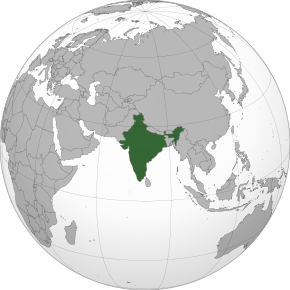More languages
More actions
No edit summary Tag: Visual edit |
No edit summary Tag: Visual edit |
||
| Line 1: | Line 1: | ||
{{Infobox country|name=Republic of India|leader_title1=President|image_flag=Flag of India.svg|leader_name2=Venkaiah Naidu|leader_name1=Ram Nath Kovind|leader_name3=Narendra Modi|leader_title3=Prime Minister|leader_title2=Vice President|government_type=Federal parliamentary bourgeois republic|native_name=भारत गणराज्य|mode_of_production=[[Capitalism]]|area_km2=3,287,263|population_estimate_year=2018|population_estimate=1,352,642,280|image_coat=Emblem of India.svg|capital=New Delhi|largest_city=Mumbai|image_map=India_Map.svg|map_width=290|map_caption=|official_languages=Hindi<br>English}} | {{Infobox country|name=Republic of India|leader_title1=President|image_flag=Flag of India.svg|leader_name2=Venkaiah Naidu|leader_name1=Ram Nath Kovind|leader_name3=[[Narendra Modi]]|leader_title3=Prime Minister|leader_title2=Vice President|government_type=Federal parliamentary bourgeois republic|native_name=भारत गणराज्य|mode_of_production=[[Capitalism]]|area_km2=3,287,263|population_estimate_year=2018|population_estimate=1,352,642,280|image_coat=Emblem of India.svg|capital=New Delhi|largest_city=Mumbai|image_map=India_Map.svg|map_width=290|map_caption=|official_languages=Hindi<br>English}} | ||
'''India''', officially the '''Republic of India''', is a [[bourgeois]] country in [[South Asia]] and the second most-populated country in the world behind the [[People's Republic of China]].<ref>{{Citation|author=Philip B. Calkins|year=2022|title=India|chapter=|section=|page=|quote=|pdf=|city=|publisher=Encyclopedia Britannica|isbn=|doi=|lg=|mia=|title-url=https://www.britannica.com/place/India|chapter-url=|trans-title=|trans-lang=}}</ref> | '''India''', officially the '''Republic of India''', is a [[bourgeois]] country in [[South Asia]] and the second most-populated country in the world behind the [[People's Republic of China]].<ref>{{Citation|author=Philip B. Calkins|year=2022|title=India|chapter=|section=|page=|quote=|pdf=|city=|publisher=Encyclopedia Britannica|isbn=|doi=|lg=|mia=|title-url=https://www.britannica.com/place/India|chapter-url=|trans-title=|trans-lang=}}</ref> Dozens of languages are spoken in India, and the country has a large [[Islam|Muslim]] minority that makes up 10% of the world's Muslim population.<ref>{{Web citation|date=2014-05-22|title=The election of Narendra Modi and the dangerous rise of India’s far-right|url=https://www.liberationnews.org/the-election-of-narendra-modi-and-the-dangerous-rise-of-indias-far-right/|newspaper=[[Liberation News]]|archive-url=https://web.archive.org/web/20190714163244/https://www.liberationnews.org/the-election-of-narendra-modi-and-the-dangerous-rise-of-indias-far-right/|archive-date=2019-07-14|retrieved=2023-02-11|author=Mike Wang}}</ref> | ||
== History == | == History == | ||
Revision as of 00:03, 12 February 2023
| Republic of India भारत गणराज्य | |
|---|---|
 | |
| Capital | New Delhi |
| Largest city | Mumbai |
| Official languages | Hindi English |
| Dominant mode of production | Capitalism |
| Government | Federal parliamentary bourgeois republic |
• President | Ram Nath Kovind |
• Vice President | Venkaiah Naidu |
• Prime Minister | Narendra Modi |
| Area | |
• Total | 3,287,263 km² |
| Population | |
• 2018 estimate | 1,352,642,280 |
India, officially the Republic of India, is a bourgeois country in South Asia and the second most-populated country in the world behind the People's Republic of China.[1] Dozens of languages are spoken in India, and the country has a large Muslim minority that makes up 10% of the world's Muslim population.[2]
History
Bronze Age
An urban civilization developed in the Indus Valley around 2600 BCE. Its major cities included Mohenjo-daro and Harappa. The Indus civilization collapsed around 1900 BCE, and archaeologists found many unburied remains showing signs of violent death.[3]
Iron Age
See main article: Maurya Empire
16 states dominated northern India by 500 BCE, and the Kingdom of Magadha conquered the others by 321 BCE to form the Maurya Empire.[4]
Classical period
See main article: Gupta Empire
Early modern period
See main article: Mughal Empire
Colonization
See main article: British Raj
The British East India Company took control of India in 1765 and established a trade monopoly. The British Raj took control of India in 1847 and suppressed a rebellion in 1857. The British stole at least $44.6 trillion from India, while the population of India dropped by 20% between 1870 and 1920 and tens of millions died from famine under British rule.[5]
Independence
In 1971, the United States supported Pakistan's genocide in Bangladesh, which killed 300,000 to three million civilians and created ten million refugees.[6]
In 1989, India introduced economic changes that allowed capitalists to take control of scarce natural resources.[7]
References
- ↑ Philip B. Calkins (2022). India. Encyclopedia Britannica.
- ↑ Mike Wang (2014-05-22). "The election of Narendra Modi and the dangerous rise of India’s far-right" Liberation News. Archived from the original on 2019-07-14. Retrieved 2023-02-11.
- ↑ Neil Faulkner (2013). A Marxist History of the World: From Neanderthals to Neoliberals: 'The First Class Societies' (pp. 19–21). [PDF] Pluto Press. ISBN 9781849648639 [LG]
- ↑ Chris Harman (1999). A People's History of the World: 'Iron and empires' (p. 49). [PDF] London: Bookmarks Publications Ltd. ISBN 9781898876557 [LG]
- ↑ Jason Hickelby (2019-01-09). "How Britain Stole $45 Trillion From India And Lied About It" Black Agenda Report. Archived from the original on 2022-01-06. Retrieved 2022-09-08.
- ↑ Gary Bass (2013-11-19). "Looking Away from Genocide" The New Yorker. Archived from the original on 2019-02-14. Retrieved 2022-01-10.
- ↑ "‘India after Naxalbari: Unfinished History’" (2022-07-14). Monthly Review. Retrieved 2022-07-14.


